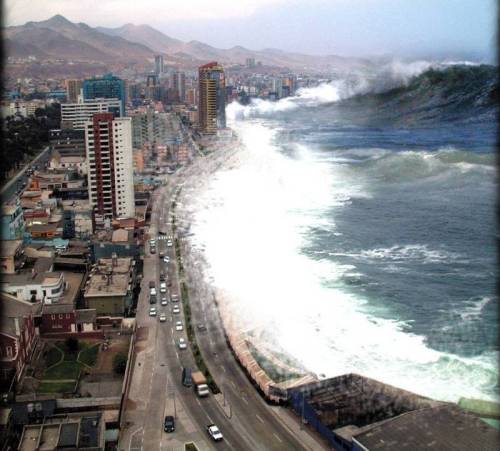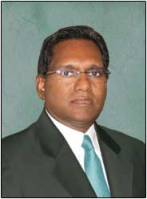.
.
December 26, 2004 – Indian Ocean earthquake and tsunami
On Sunday, December 26, 2004, an undersea megathrust earthquake, known as the Sumatra–Andaman earthquake occurred at 00:58:53 UTC in the Indian Ocean with an epicentre off the west coast of Sumatra, between Simeulue in the Aceh province of Indonesia and mainland Indonesia. The earthquake with a magnitude of Mw 9.1–9.3, is the third largest earthquake ever recorded on a seismograph.
The duration of faulting, between 8.3 and 10 minutes, was the longest ever observed. The behemothic quake caused the entire planet to vibrate as much as 1 centimetre (0.4 inches) and triggered other minor earthquakes as far away as Alaska.
The tsunami was then known by various other names such as: “The 2004 Indian Ocean tsunami,” “South Asian tsunami,” and “Indonesian tsunami.” Since the tsunami occurred on December 26, it was also known as the “Christmas tsunami” and the “Boxing Day tsunami.”

The earthquake triggered a tsunami, considered to be one of the deadliest in history, which inundated coastal communities with waves up to 100 feet (30 meters) high and killed over 230,000 people in fourteen countries. It was one of the deadliest natural disasters in recorded history.

The huge waves racing at the speed of a jet aircraft took fifteen minutes to seven hours to reach the various coastlines. The waves hit the northern regions of the Indonesian island of Sumatra immediately. Thailand was struck about two hours later, despite being closer to the epicentre because the tsunami waves travelled more slowly in the shallow Andaman Sea off its western coast. About an hour and a half to two hours after the quake, Sri Lanka and the east coast of India were hit. The waves then reached the Maldives.
Indonesia was the hardest-hit country, followed by Sri Lanka, India, and Thailand.
The earthquake and resulting tsunami in the Indian Ocean had a devastating effect on India. According to the Ministry of Home Affairs about 18,000 are estimated dead.
The following table compiled by the U.S. Geological Survey shows that a total of 227,898 people died. According to this table, in mainland India and in its territories, the Andaman and Nicobar Islands, 12,405 people died in the tsunami, around 5,640 are missing and 647,599 people have been displaced.
Figures compiled by the U.S. Geological Survey.
| Country where deaths occurred |
Confirmed | Estimated | Injured | Missing | Displaced |
|---|---|---|---|---|---|
| Indonesia | 130,736 | 167,799 | n/a | 37,063 | 500,000+ |
| Sri Lanka | 35,322 | 35,322 | 21,411 | n/a | 516,150 |
| India | 12,405 | 18,045 | n/a | 5,640 | 647,599 |
| Thailand | 5,395 | 8,212 | 8,457 | 2,817 | 7,000 |
| Somalia | 78 | 289 | n/a | n/a | 5,000 |
| Myanmar (Burma) | 61 | 400–600 | 45 | 200 | 3,200 |
| Maldives | 82 | 108 | n/a | 26 | 15,000+ |
| Malaysia | 68 | 75 | 299 | 6 | 5,000+ |
| Tanzania | 10 | 13 | n/a | n/a | n/a |
| Seychelles | 3 | 3 | 57 | n/a | 200[70] |
| Bangladesh | 2 | 2 | n/a | n/a | n/a |
| South Africa | 2 | 2 | n/a | n/a | n/a |
| Yemen | 2 | 2 | n/a | n/a | n/a |
| Kenya | 1 | 1 | 2 | n/a | n/a |
| Madagascar | n/a | n/a | n/a | n/a | 1,000+ |
| Total | ~184,167 | ~230,273 | ~125,000 | ~45,752 | ~1.69 million |
.
The Andaman and Nicobar Islands in the Indian Ocean were devastated by the tsunami, and by the initial quake and several aftershocks that occurred during the following days. The Great Nicobar and Car Nicobar islands were the worst hit among all the islands due to their proximity to the epicentre of the quake and because of the relatively flat terrain.
One-fifth of the population in Nicobar Islands was reported dead, missing or wounded. Chowra Island lost two-thirds of its population of 1,500. Communication was cut off when many islands submerged. The Trinket Island was bifurcated.
Fishing communities were destroyed and very little is known about the effects of the tsunami on the indigenous tribes of the Andaman and Nicobar islands.
The official death toll in the Andaman and Nicobar Islands was 1,310, with about 5,600 missing from the islands. But the unofficial death toll, including those missing and presumed dead, was estimated to be around 7,000.

The tsunami hit the southeastern regions of the Indian mainland. It inundated villages and devastated cities along the coast. Around 8,000 deaths were reported from Tamilnadu, and around 200 deaths from Kerala. The district of Nagapattinam was the worst hit in Tamil Nadu, with nearly 5,500 deaths.

Surprisingly, Bangladesh, which lies at the northern end of the Bay of Bengal, had only two confirmed deaths, despite being a low-lying country and located relatively near the epicenter. Also, distance alone does not guarantee a safety since Somalia located in the Horn of Africa on the eastern coast was hit harder than Bangladesh even though it is much farther away.
Coasts, with a landmass between them and the location of origin of a tsunami, are usually deemed safe, but tsunami waves can sometimes steer around such landmasses. Being a relatively small island, the western coast of Sri Lanka suffered substantial damages from the impact of the tsunami; likewise, the Indian state of Kerala too was hit by the tsunami, despite being on the western coast of India.
The government of India announced a financial package of about US$200 million to Andaman and Nicobar islands after the tsunami, but the unbearable living conditions due to rise in sea level, constant aftershocks and fear of another similar tsunami, propelled thousands of settlers on the islands to relocate to the Indian mainland.
According to the World Bank, reconstruction was expected to cost more than US$1.2 billion in India alone.
.
.
.
RELATED ARTICLES
- India and Day 26 – Part 1: India’s Independence Day and Republic Day (tvaraj.com)
- India and Day 26 – Part 2: Turmoil in Gujarat (tvaraj.com)
- India and Day 26 – Part 4: Terrorist Attacks in Mumbai – 1 (tvaraj.com)
- India and Day 26 – Part 4: Terrorist Attacks in Mumbai – 2 (tvaraj.com)
- India and Day 26 – Part 5: Resurgence of the BJP (tvaraj.com)
- 2004 Indian Ocean earthquake and tsunami (en.wikipedia.org)
- Effect of the 2004 Indian Ocean earthquake on India (en.wikipedia.org)
- Tsunami’s impact on India (academic.evergreen.edu)
.










